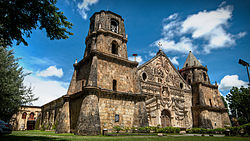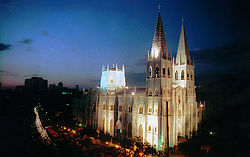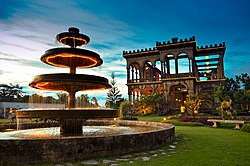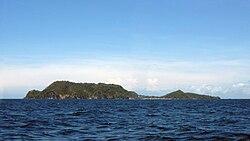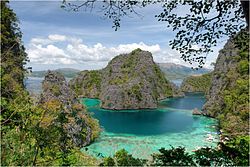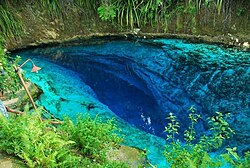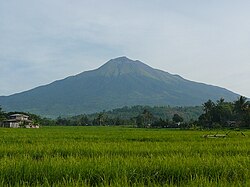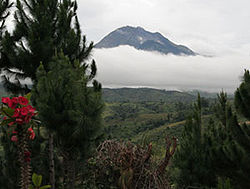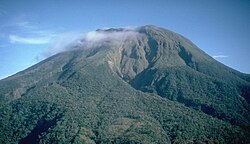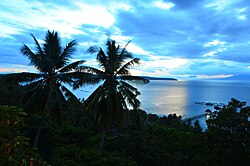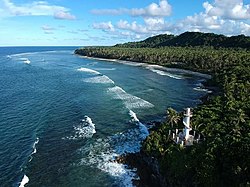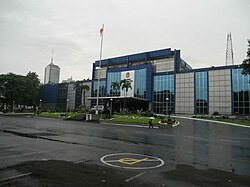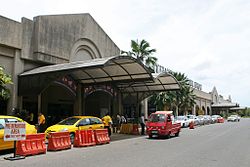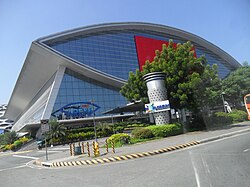Amusement, national and natural parks, and monuments
- Color Key
| Name | Image | City/Municipality | Province | Region | Notes |
|---|---|---|---|---|---|
| Bataan National Park |  | Bataan | Central Luzon | ||
| Biak-na-Bato National Park |  | Bulacan | Central Luzon | ||
| Enchanted Kingdom [1] |  | Santa Rosa | Laguna | Calabarzon | |
| Kalbario-Patapat Natural Park |  | Ilocos Norte | Ilocos Region | The natural park was established on April 20, 2007, by Proclamation no. 1275 encompassing 3,800 hectares (9,400 acres) with a buffer zone of 1,937 hectares (4,790 acres). The park was created under the National Integrated Protected Areas System (NIPAS) of the Department of Environment and Natural Resources. [2] | |
| MacArthur Landing Memorial National Park [3] | Palo | Leyte | Eastern Visayas | It was declared a national park on July 12, 1977, through Letter of Instructions No. 572 signed by President Ferdinand Marcos. [4] | |
| Manila Ocean Park |  | Ermita, Manila | Metro Manila (National Capital Region) | ||
| Mayon Volcano National Park |  | Albay | Bicol Region | First protected as a National Park in 1938, it was reclassified as a Natural Park in the year 2000. [5] | |
| Mount Apo Natural Park |  | Declared a National Park by Manuel L. Quezon through Proclamations No. 59 on May 9, 1936, and No. 35 on May 8, 1966 [6] | |||
| Mounts Iglit-Baco National Park |  | Occidental Mindoro | Mimaropa | A protected sanctuary and home to the Tamaraws endemic to the island of Mindoro. Established as a National Park on November 9, 1970, by virtue of Republic Act No. 6148. [7] Listed by ASEAN as one of the nine heritage parks in the Philippines in 2003. [8] The park has also been nominated in the Tentative List of UNESCO World Heritage Sites. [9] | |
| Nagcarlan Underground Cemetery [10] |  | Nagcarlan | Laguna | Calabarzon | It is dubbed as the only underground cemetery in the country. [11] |
| Paco Park |  | Paco, Manila | Metro Manila (National Capital Region) | It was once Manila's municipal cemetery built by the Dominicans. Dr. Jose Protacio Rizal, Philippine National Hero, was secretly interred at Paco Park after his execution at Bagumbayan on December 30, 1896, and was guarded for fifteen days by the Guardia Civil Veterana. His remains were exhumed on August 17, 1898, and on December 30, 1912, was laid underneath the monument dedicated to him at the Luneta as stated in the Park's marker. [12] [13] | |
| Quezon Memorial Circle [14] | Quezon City | Metro Manila (National Capital Region) | Its main feature is a tall mausoleum containing the remains of Manuel L. Quezon, the second official President of the Philippines and the first of an internationally recognized independent Philippines, and his wife, First Lady Aurora Quezon. [15] | ||
| Rizal Park [16] |  | Roxas Boulevard, Manila | Metro Manila (National Capital Region) | The park was a tribute to the Philippine's national hero, Jose Rizal, a doctor and novelist who was shot by firing squad at this site on December 30, 1896. [17] | |
| Salinas Natural Monument |  | Nueva Vizcaya | Central Luzon | The park was established on May 18, 1914, as the Salinas Forest Reserve covering the Salinas Salt Springs and surrounding forest through Executive Order No. 44 signed by Governor-General Francis Burton Harrison. It was finally declared a natural monument in 2000 under the National Integrated Protected Areas System through Proclamation No. 275 by President Joseph Estrada. [18] [19] | |
| Star City |  | CCP Complex, Pasay | Metro Manila (National Capital Region) | ||

























